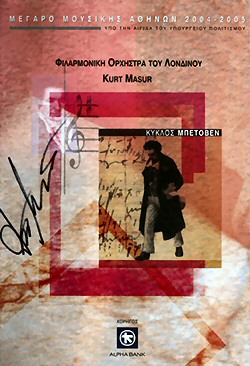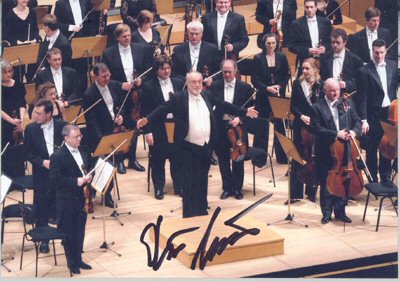Seen and Heard
International Concert Review
The London Philharmonic Orchestra in
Athens: Beethoven Cycle, Soloists, London Philharmonic
Orchestra, Kurt Masur, Megaron, Athens, 12th to 15th January 2005
(ARi)
Ludwig van Beethoven:
Symphony No. 1 in C Major, Op. 21 (1800)
Symphony No. 2 in D Major, Op. 36 (1802)
Symphony No. 3 "Eroica" in E Flat Major, Op. 55 (1803)
12th January 2005
Symphony No. 4 in B Flat Major, Op. 60 (1806)
Symphony No. 5 in C minor, Op. 67 (1807)
13th January 2005
Symphony No. 6 "Pastoral" in F Major, Op. 68 (1808)
Symphony No. 7 in A Major, Op. 92 (1812)
14th January 2005
Symphony No. 8 in F Major, Op. 93 (1812)
Symphony No. 9 "Choral" in D minor, Op. 125 (1824)
Christine Brewer (soprano)
Carolin Masur (mezzo soprano)
Thomas Studebaker (tenor)
Alastair Miles (bass)
London Philharmonic Choir
Manolis Kalomiris” Children Choir
15th January 2005
After an unsuccessful attempt to present the complete Beethoven
symphonies in Athens two years ago, and after the very good Brahms
cycle of last year, the London Philharmonic Orchestra and Kurt Masur
offered the Athens audience Beethoven’s symphonic legacy in
four sold-out concerts.

In the opening movement of the First Symphony the orchestra’s
reading was elegant but Masur’s approach, despite the very
fast tempi, failed to convey the overall feeling of gaiety and happiness.
The same was also true of the third movement, except perhaps for
a very successful dialogue between the winds and strings in the
Trio. The final movement was the most successful of all with beautiful
phrasing from the second violins.
The Second Symphony’s slow introduction brought with it gentle
statements from the winds and the main theme of the allegro
con brio section underlined beautifully the energetic and cheerful
character of the music. The lyrical theme of the second movement
had grace, lightness and exceptionally well-phrased statements from
the horns and bassoon. After an indifferent scherzo, a perfect,
thunderous rondo followed, its impressive first theme performed
furiously, as it should be. Clarinet and bassoon introduced lyrically
the second theme, and this was well contrasted with the explosive
repeat of the first theme.
The introductory first two chords of the Eroica were played
in tempo and with weighty significance; but the main theme simply
lacked heroic tension. I have never understood how - and why - certain
conductors appear so restrained here, as if they are not overwhelmed
by this stormy music. The orchestra’s playing was largely
without contrast, and this was especially so when the second theme
emerged from the winds to be taken up by the first violins. The
recapitulation featured very good playing by the horns, however.
The Funeral March was understated and the crescendo not
sufficiently weighty. The third movement was very well articulated
but the winds solos were quite often approximate; pizzicati in the
finale’s introductory theme were impressively accurate. However,
this was a performance which gave little, or no, opportunity to
experience the score’s triumphant character.
The joyfulness of the Fourth Symphony’s introductory movement
did not emerge in Masur’s reading, which appeared stiff and
lacked a bel canto quality. However, the flute was exceptionally
fine and the string attacks well rehearsed. The slow movement enraptured
the audience immediately; it remained totally silent throughout
its duration. Both orchestra and maestro were incredibly concentrated
and offered us moments of pure emotion and tenderness. The Scherzo
was played satisfactorily but without any contrasting effects between
the minuet and trio. The finale lacked the enthusiastic treatment
I prefer in this work.
The Fifth Symphony’s first movement received a fabulous, straight-forward
reading full of genuine passion and fire; miraculously, Masur left
the orchestra time and space to breathe. The serenity of the following
movement was happily interrupted by a powerful, and elaborately
phrased crescendi. The scherzo was introduced by dark and warm celli
leading to a quite impressive performance of the fugato Trio section.
The transition to the final movement was in the spirit of Masur’s
overall conception of this particular work, avoiding the rallentandi
very often used (and misused) by others in this section - although
I was tempted to prefer a little more suspense. The final movement
was full of character, brio, grandeur and orchestral precision;
a real delight for the mind and the heart and the peak of the cycle
so far.
The third day opened with the Pastoral. The introductory
movement was played in an ideal tempo, and both orchestra and conductor
stated the popular themes nicely with great playing from the strings.
The second movement advanced steadily and in an unaltered tempo
until the end, with beautiful contributions from the wind soloists.
The horns sounded a little too loud in the third movement but had
a charming and warm tone. The tempest burst naturally - but not
wildly – with Masur preferring to let the music to speak for
itself. The finale, unfortunately, was rather cold and indifferent;
if only the orchestra’s strings and admirable woodwinds hade
been allowed more involvement!
The poco sostenuto introduction to the Seventh Symphony
should have been more involved and sustained in order to contrast
with the flute solo (played without grace) in the exposition of
the principal theme of the movement’s main body. But these
were the only unwelcome aspects of Masur’s interpretation
and the orchestra’s performance; it emerged into an unforgettable
experience. Incredible tutti were sung and danced in lively tempi,
bringing us into a world of total happiness and joy. In contrast,
the ritual dances of the second movement were very strict rhythmically
and were supported by an orchestra in exstasis. The scherzo was
performed brilliantly, respecting the presto indication set by the
composer, and if the Trio was on the fast side it was notable for
a great contribution from trumpets playing to their limits. Almost
without a break - and without any sign of fatigue - the orchestra
released their rich reserves and offered us a fast and generous
conclusion to this symphony. A technically impressive and exhilarating
account that will linger long in the memory.
The Eighth symphony, which opened the last day
of this cycle (preceded by a welcome greeting in Greek from Kurt
Masur to Mikis Theodorakis who was present in the hall), seemed
to be less well rehearsed than the others since quite often we encountered
unclear sonorities and weak balances. Nevertheless, the second movement
was noble and gentle, and masterly constructed and executed. The
third movement suffered from some orchestral inaccuracies and it
was unfortunate that the horns sounded insecure. The final movement
succeeded only due to the strings’ impeccable playing.
The first measures of the Ninth defined the grandeur of the performance.
Lively tempi, together with a sense of understanding of the movement’s
complex inner architecture, gave this movement the epic character
it deserves. The sharp fortissimo beats that introduced the second
movement, together with the impulse and power that governed the
scherzo, convinced me that his Ninth would be the best I had ever
experienced in a concert. The slow movement was notable for disarming
phrasing and simplicity. The second violins and violas could not
have underlined any better the serenity of the divine second theme,
this masterpiece’s humanitarian message being clearly conveyed
to the audience. I think Masur managed to find the golden rule between
the late romantic and historically informed approaches. Without
metaphysical demonstration, the orchestra stated dramatically the
“fanfare of terror” and expressed perfectly all the
movement’s different moods until the first statement of the
main theme, “Ode to Joy” on the woodwinds. The quartet
of soloists had a rare homogeneity, which was immediately noticeable.
Together with the incredibly accurate Choir we lived moments of
grace, inspiration and happiness. The audience honored this important
event with long ovations and as the Maestro told me backstage he
wishes to come back next year with a Schumann cycle.
Alexandros Rigas





